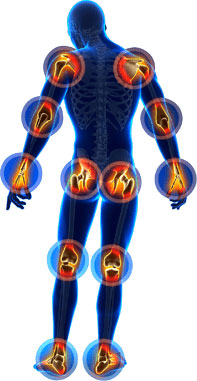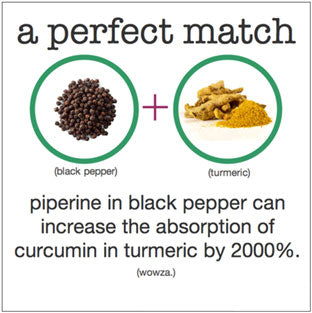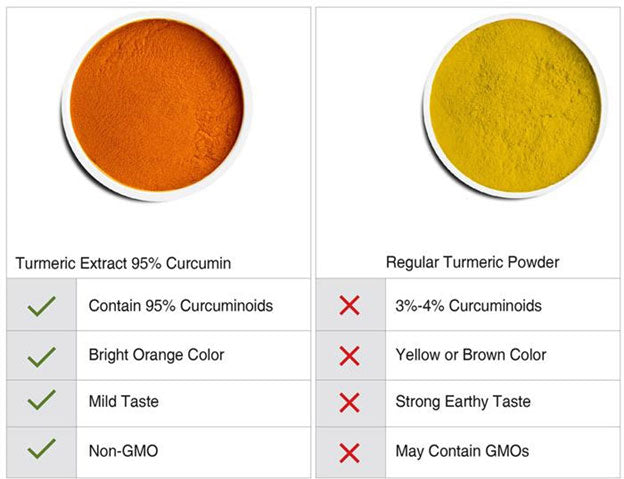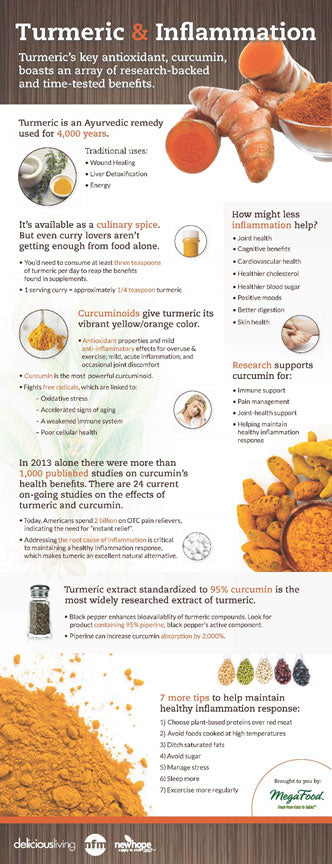
How Effective Is Turmeric For Joint Pain Relief?
Pain is an unpleasant sensation that hurts or makes you feel uncomfortable. While everyone’s tolerance for pain varies, most people look for some sort of relief from it.
Pain is the body’s signal that something isn’t quite right. Most people recognize pain that occurs frequently as the results of a disease, surgery, or injury. Inflammation may be one such injury, as it’s the cause of arthritis and other joint pain troubles. The dangers of inflammation reach far and wide beyond joint pain, from heart disease to dementia, if left untreated.
Treat the inflammation, and you treat the root cause. Treat the root cause, and the symptoms – the pain – goes away.
Over the counter options for pain relief are available, but they cannot typically be taken on a daily basis, due to the accompanying side effects and the risk of damage to the liver or kidneys.
Natural pain relief options are generally much safer, however, and there are many options. One such option which, proven time and time again, is turmeric root’s active compound, curcumin. You can use regular turmeric root as a spice in your food, yes, but you might not see the same benefits quite as quickly as an extract.
Turmeric’s effect on joint pain is important for most people in today’s world. With up to 23% of adults in America suffering from joint pain, it’s no wonder that turmeric is taking the market by storm. We’re all ecstatic for a new remedy; especially one that works, unlike most medications on the shelves right now.
Most people will find themselves unable to go a week without seeing an advertisement or product available for joint pain relief, but many people are still searching for a better solution due to the lack of safe and affordable options.
With complaints popping up all over the globe about the prescription drug industry, it’s about time that we’ve locked onto a good, natural remedy for joint pain.
Two Basic Types of Pain

Pain can usually be divided into two categories: chronic and acute.
No matter which type of pain is involved, a turmeric supplement can be used to minimize the discomfort.
Chronic pain is ongoing and typically occurs every day. It is defined as a medical condition as it can lead to more serious complications. Chronic pain is often resistant to attempted cures and requires constant management to address it.
Acute pain typically refers to sharp pain that occur suddenly and go away after a time. If you stubbed your toe, the resulting pain is acute pain, not chronic. It is true, however, that acute pain has the potential to become chronic, particularly if the cause of the pain is not treated and resolved.
Nature contains some of the safest and most powerful, effective therapies.
One treatment option that has been successfully used for centuries is turmeric root. This bright yellow spice has been used in India for both medicinal and culinary reasons, and in Chinese medicine for over 2,000 years.
It is also commonly used in Thai, Indian, Persian, and Pakistani dishes. Not only is turmeric tasty, but it helps with joint pain, stiffness, and inflammation. Scientists have understandably taken a liking to studying this wonderful root and its medicinal properties it, trying to either prove or disprove the claims laid from hundreds of years of documentation and trade. They've found surmounting evidence that many of these claims are true, and Turmeric has become even more popular in the United States over the last few years through the popularization of cultural dishes and the ever-increasing need for medicine and relief from various ailments.
With all these wondrous claims around Turmeric, it didn’t take long for studies to begin. These studies found a variety of truths in the claims from other cultures such as anti-inflammatory effects, anti-carcinogenic, anti-oxidant and many other properties.
How Does Turmeric Work?

Turmeric is a leafy plant with roots at the bottom, called rhizomes. These rhizomes contain a specific set of compounds called curcuminoids. The main curcuminoid, curcumin, is responsible for the majority of its health benefits.
This little compound has undergone hundreds of clinical trials and studies to prove its benefits for several health ailments from immune system health to lowering blood pressure.
Research has pointed to curcumin, an active ingredient contained inside the turmeric root. This compound is responsible for treating joint issues, inflammation, and dozens of other ailments.
Turmeric works to decrease inflammation through multiple channels. One such way is as an antioxidant. Curcumin works to protect the cells from oxidation – while this is normal, too much oxidation can damage cells and create free radicals. Curcumin targets and attacks free radicals and does away with them.
Not only has this relieved hundreds of people of their daily joint pain and arthritis, but since free radicals are the root cause of aging, this compound makes an excellent anti-aging agent.
Arthritis.org has also released a supplement guide on turmeric and how it affects joint pain and inflammation.
How Do You Choose the Right Turmeric?
(Click the image to view larger version)
With evidence coming to light of turmeric’s benefits, many people have begun taking a turmeric supplement for their joint pain or arthritis troubles.
The benefits are not only incredible, but sustainable, so it makes sense that people would want a product that finally works.
Of course, if you’re looking for pain relief, not just any turmeric will do. The trick is finding the right amount of curcumin in your turmeric supplement.
Turmeric root on its own is not harvested with curcumin content in mind, so crop growers focus more on optimal taste, rather than medicinal benefits. A lot of the curcumin content in turmeric root develops as it ‘ripens’. The taste, however, is strongest right before that stage, which unfortunately means it is usually harvested before it has a chance to develop high enough levels of curcumin for any medicinal benefit.
Turmeric already has a low curcumin content which our bodies have a hard time absorbing, which we cover across our site at MeFirstLiving.com
Because of this, the turmeric root or ground root powder you can find in many grocery stores will contain a stale curcumin content – if any at all – and you won’t receive much benefit from the root at all.
It’s best to choose a standardized extract of 95% curcumin instead of purchasing the raw root or root powder. This helps ensure you are getting the correct amount of curcumin, instead of wasting your money on filler supplements and root powders.
At its highest concentration, fresh turmeric root typically only contains 3% curcuminoids. You’d have to eat a lot of turmeric root to have the same benefits as a few grams of standardized extract.

Of course, that’s not all.
Curcumin is not readily bioavailable, meaning your body will have a hard time absorbing all the nutrients and health benefits that come from curcumin.
Me First Living has added a black pepper extract to help ensure you get the most out of your curcumin extract. Turmeric with black pepper is a superb combination, as many of the benefits are complimentary.
Many suppliers and manufacturers might claim to have better bioavailability with curcumin alone, but they can’t be guaranteed unless their product contains black pepper extract as well.
One study compared the absorption of curcumin through different methods concluded that adding natural antioxidants can greatly increase the levels of curcumin absorbed into the body. We chose a black pepper extract, as it’s a powerful antioxidant as well.
So, what is this black pepper extract?
The active ingredient in black pepper is called piperine. This compound has been shown to halve the time in which it takes for curcumin benefits to show in lab studies in tests.
It has also been shown to increase the half-life in benefits, both in rats and humans, with no adverse effects.
The increase in curcumin’s bioavailability is a little over 2000%, thanks to the addition to piperine, in the form of Bioperine® to our supplement.

Is There Proof of Turmeric Benefits?
Several studies have proven the effectiveness of turmeric and curcumin extract, typically taken in supplement form.
Turmeric plays a therapeutic role in the diet of many individuals who suffer from chronic arthritis and joint pain symptoms.
Extensive clinical trials have been performed on the efficacy of turmeric and curcumin individually, providing extraordinary results in tests and placebo trials. Much of the arthritis relief benefits of turmeric is thanks to curcumin’s anti-inflammatory properties, helping ease the swelling and tension between sensitive joints and strained bones.
Curcumin is also known to include a high amount of antioxidants that help your body fight free radical molecules. These molecules often react with organic substances such as fatty acids, proteins, or even DNA sequences. These radicals are thought to be one of the main mechanisms behind oxidative damage and ailments such as joint pain an arthritis as they can collect and hurt your bodily functions.
It’s important to help your body fight these damaging forces. Fortunately, curcumin, the main compound in turmeric, can help unbind these free radicals, helping give your body a little bit of “grease for the wheels” as some might say.
A study on curcumin with patients who suffered from knee osteoarthritis (OA) were randomly selected to receive a turmeric supplement, or 800mg of ibuprofen a day for six weeks. They would them be asked to walk a certain distance to test their pain and function levels. After the trial, it was concluded that turmeric and ibuprofen were equally effective in treating pain, with turmeric winning out on more than one occasion, without any harmful side effects.
In 2012, a small study from Arthritis.org concluded that patients with rheumatoid arthritis has just as much relief from a supplement containing curcumin extract as they did with an anti-inflammatory drug.
An Italian study was completed and showed similar results to the above. The team created a special supplement meant to maximize the absorption of turmeric in the body. After three months, the results showed that the group taking the supplement saw a 300% improvement in their symptoms and general well-being.

We can never be sure how this kind of information will be taken by the general public or even medical workers.
Just because scientists have proven that Turmeric provides incredible joint pain relief thanks to its anti-inflammatory properties doesn't mean that it will be taken seriously.
Too many people seem to have forgotten that our modern-day medicines were all originally extracts of various plants and roots.
What this means for you, however, is a bright future with less everyday pain and aches caused by arthritis, cramps, and other joint pains.
Does Turmeric Have Any Negative Effects?
We’ve just covered all the great benefits, so you might be thinking, “what’s the catch?”
Turmeric is not dangerous, and many studies have been done to test the safety of curcumin extract, showing it to be safe across the board in recommended dosages. Taking larger than recommended amounts for a long period of time, however, can result in upset stomach and nausea.
Just because something is a natural herbal extract doesn’t mean that it won’t interact with other medications or supplements you may be taking.
Turmeric and curcumin can both lower blood sugar and thin the blood, so if you are diabetic, taking a blood thinner, or have an upcoming surgery, you should stop use of turmeric and consult your doctor.
In some individuals it may cause an allergic reaction, especially if you have previously had an allergic reaction to roots in the Ginger (Zingiberaceae) family.
If you are pregnant or breastfeeding, you should avoid taking turmeric as the safety has not been evaluated for babies.
Some prescription medications may interact with turmeric, so it’s always best to consult your doctor or healthcare professional before you begin taking a turmeric or curcumin supplement, or if you are already.
How to Determine the Ideal Turmeric Dosage for Pain Relief

The ideal dosage depends on the percent of curcumin in the supplement, not turmeric root powder. Remember when we discussed curcumin earlier?
Choosing a supplement with a lower percentage of curcuminoids won’t produce the same beneficial results as a supplement with a higher percentage, unless you take more of the first.
Many sources suggest that taking 500 milligrams of curcumin each day is enough to assist in minimizing pain.
It is important to note, however, that everyone’s circumstances are different. Accompanying issues such as mental and environmental stress can influence how well 500mg of any supplement are absorbed in the body, as stresses can lower your body’s absorption of nutrients.
If 500mg isn’t producing the desired results, it may be necessary to increase the dosage. If you choose to do so, it is important to do it gradually to avoid stomach upset.
Since turmeric and curcumin are not medications, you won’t find any physician-recommended dosages for it; however, valuable insight from years of research and feedback from individuals taking turmeric suggest the following doses are beneficial for pain relief in adults:

Fluid Extract – 30 to 90 drops per day
Tincture – 15 to 30 drops per day
Dried Curcumin Powder: 400 to 600 mg, three times per day
Dried Turmeric Root Powder: 1 to 3 grams per day
Cut root: 1.5 to 3 grams per day
How Do I Take Turmeric For Joint Pain Relief?
First, consider how bad your pain is and what efficacy you want you want from turmeric. Do you need something that kicks pain in the butt, or do you just need something to gently nudge it away?
The least effective type of turmeric for joint pain is the pre-dried culinary spice, followed by the middle option of the fresh root. If you can find the fresh root right after it has been allowed to ripen and harvested, this will be the best option out of the two.
Environmental conditions in grocery stores and shipping containers have a tendency to let the rhizome go ‘stale’ on the road and lose a lot of the nutrients, especially if it is pre-ground.
The best option that provides the most effective type of turmeric for joint pain is a standardized curcumin extract with added piperine.
Of course, turmeric is available in a few different forms if taken as a supplement. You can find it in capsules, a fluid extract, and tincture form. You might find bromelain or piperine in many supplements to help increase the anti-inflammatory effects of curcumin and improve bioavailability.
At Me First Living, we use Bioperine® which is a proven piperine extraction.
Before You Take Turmeric…
However you decide to take your turmeric or curcumin supplement, we suggest taking note of your current mobility, pain levels from 1 to 10, joint pain symptoms, and so on.
Turmeric isn’t a supplement you’ll notice right away like you might caffeine. Many consumers claim they didn’t notice turmeric’s benefits as much as they did until they stopped taking it! That is because the benefits of turmeric happen gradually.
Remember, the quality of your turmeric greatly affects how your body responds to it. If you are taking a supplement, its quality and composition both make a different in how well it will perform. These two factors may also influence how much you may need to take before you feel any benefit from doing so. That is why it’s so important to choose a standardized turmeric product.
It is wonderful news to know there are alternative ways to deal with chronic joint pain, especially if you’re looking to ditch the mountain of pills that are supposed to treat a single problem. Turmeric has been shown time and time again that it is excellent for a variety of ailments, aches, pains, and general well-being.
Before you jump in and grab the first product on the shelf, however, it’s important to make an educated choice and select a product that is best for you, and experiment with how you like taking your curcumin. Try the Me First Living Buyer’s Guide today and find the best supplements for you.
Always consult your doctor before you begin taking any supplements. If you are unsure whether you are allergic to the ginger (Zingiberaceae) family, you may want to have an allergy test done.
After all, life is about enjoying little moments to their fullest, so you should be able to pursue the hobbies and activities that bring your joy.
We invite you to share some of the experiences you’ve had with different Turmeric supplements and extracts in the comments below!

